Because Bolas spiders throw their lassoos faster than the human eye can see, it required a special technique to take this picture.
We did not create the heavens and the earth and everything between them as a game. We did not create them except with truth, but most of them do not know it. (Surat ad-Dukhan: 38-39)

Most people think of the spider as an animal that just uses a web to catch its prey. But this by no means tells the whole story, because these webs, each one a wonder of architecture and engineering, are not the only means by which spiders catch their prey. Besides spinning webs, spiders employ some surprising tactics when hunting.
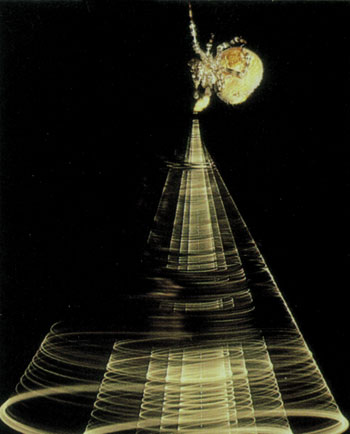 Because Bolas spiders throw their lassoos faster than the human eye can see, it required a special technique to take this picture. |
Of all the many species of spider, one of the most interesting, because of its hunting techniques, is the "Bolas" spider. Dr. Gertsch, an expert on spiders, has established as a result of his detailed research on this creature, that it uses a noose to catch its prey.
Bolas spiders hunt their prey in two stages. In the first stage the spider spins a thread with a sticky end and lies in ambush. Later it will use this sticky thread as a lassoo. Then, in order to attract its prey to it, the spider gives off a very special chemical. This is a "pheromone," which female moths use to attract males for mating. The male moth, deceived by the counterfeit call, approaches the source of the smell. The spiders have very poor eyesight, but can make out the vibrations set up by the moth as it flies. In this way the spider can feel its prey approaching it. Now the interesting thing is that, despite the fact that the Bolas spider is almost blind, it can catch a flying, living creature with a thread it makes itself hanging in the air.
The book, Strange Things Animals Do, likens the spiders' hunting technique to a cowboy throwing a lassoo:
The spider spins a silky cord, then puts a weight on one end — a heavy bit of gum. In this way, the weapon reminds one of a cowboy's lassoo. Then it takes the cord up in its two front legs, which now act like arms. When a moth flies by, it throws the lassoo. The sticky, weighted end hits the body of the flying insect and sticks to it. The moth is then roped in and the Bolas spider wraps it up.4
The second stage begins when the victim, deceived by the smell, approaches. Drawing its legs back the spider gets into the attack position and throws the lassoo faster than the human eye can see. The moth is caught by the sticky ball at the end of the thread. The spider reels its prey in and bites it, paralysing it. Next it wraps the moth up in a special thread, which keeps the food fresh for a long time. In this way the spider preserves its food for later consumption.
In the same book the writer evaluates the spiders' planned movements in these terms:
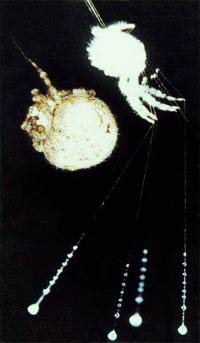
Scientists call the bolas a lesser creature. Dr. Gertsch is not sure that this is an accurate term for her. Because what a trained sea lion, a dog, or a tiger cannot do, what even a great ape cannot do, what even a cowboy finds difficult - this so-called lesser creature does.5
It is therefore clear that the Bolas spider's hunting technique requires a special skill, and is even based on gaining experience through practice. If we examine the process stage by stage the difficult nature of what the spider does becomes more apparent. Let us look at the answer to the question, "What does the Bolas spider have to do when hunting?"
- It prepares a sticky ball on the end of a thread.
- It produces in its body and releases a smell given off by females of another insect species to attract males.
- It throws the lassoo at its prey faster than the human eye can see.
- It aims the lassoo at its prey and hits it.
- Finally, it has to produce a special thread which will keep the prey fresh, and then wraps it up.
So, how is the Bolas spider able to operate within the framework of such a clever plan? Making plans is a feature of creatures which possess the power of reasoning, i.e. human beings. Furthermore, the spider's brain does not have the capacity to conceive all this and carry it out. But, in that case, how did it come to possess a hunting technique with such striking characteristics? That is a question scientists are still trying to find the answer to.
According to evolutionists, spiders owe all their characteristics to coincidences. The spider decided to make a lassoo, carried out the chemical production, knew that it had to attract the moth towards it and came to have the skill to hit the target with the lassoo, all by coincidence. All the other qualities it would need to hunt with a lassoo came about entirely by coincidence. It is obvious that claims based on coincidence are just fantasy, with no scientific or logical foundation. In order to see clearer just how far the evolutionists' fantasies are from scientific fact let us imagine a little scenario, despite all the impossibilities.
Scenario: A long time ago a spider, realising that it was unable to build webs like other spiders, began to look carefully around it. One day it noticed that female moths were using a chemical to attract males. It thought that in order to catch the moths it would have to produce the same chemical, built a chemistry laboratory inside its own body and began to manufacture the chemical. But its problems were not yet over. Because unless it could catch the moths there was no point in attracting them. At that point it had another idea, and from the thread it produced it made a weapon, a cross between a lassoo and a mace.
But just making the weapon was not enough. The first time it went hunting, unless it could hit the target all its efforts would go to waste, even worse it would die of hunger. But it did not happen that way, and it caught its prey, and after that it "succeeded" in developing a perfect hunting technique. After that it thought of teaching the technique, in every tiny detail, to the other spiders and found a way of transmitting this knowledge to following generations.
These are just parts of a scenario. But is not just enough for the scenario to be written down. The scenario has to be translated into reality. To this end let us consider some imaginary alternatives within the scope of the imaginary scenario.
Imaginary Alternative 1: This consists of what evolutionists call "Mother Nature," that is trees, flowers, the sky, water, rain, the sun, etc. Then there are all the forces of nature, acting in harmony to establish a perfectly functioning system. In the process the Bolas spider is not forgotten and it is ensured that it comes to possess a good hunting technique.
Imaginary Alternative 2: Pure coincidence, again described by evolutionists as an active force, comes to the assistance of the Bolas spider, as to all other hunters, and enables it to come into possession of predatory skills.
Naturally, these are nothing but fantasies, the products of an active imagination. The possessors of this active imagination are the evolutionary scientists. Before moving on to the actual answer, let us examine how illogical and invalid and baseless these scenarios are.
- Evidently the Bolas spider is not a chemical engineer! It is not possible for it to study the chemicals released by the moths and carry out an analysis of them, then starting to knowingly create the same chemical within its own body. To claim this is diametrically opposed to intelligence, logic, and science.
- The spider has no other use for the chemical given off by the moths than for hunting. Even if it had reproduced it by coincidence, it would have to understand the similarity between the scent given off by the moths and its own scent. Then, analysing this resemblance it would have to have the intelligence to make use of it in its own interest.
- Even if we accept that the spider had in some way "learned" about the nature of the scent given off by the moths and had been "clever enough" to use this in its own favour, then it has to be able to make the necessary physical changes to produce that material. It is not possible for any living creature, of its own volition, to add an extra organ or chemical production system to its own body. Even thinking that a spider might be capable of doing such a thing, let alone actually claiming it as fact, means leaving the realms of logic far behind.
No matter how impossible, let us imagine that the spider did actually come to have all these characteristics we have discussed by coincidence. Now it is necessary for the spider to have "thought of" using a lassoo to catch the moths and after "designing" it to be able, of its own volition, to create it.
It is clear from this that when one carefully examines the characteristics of the Bolas spider, one gets a better understanding of just how comic the claim of the theory of evolution, completely based on coincidences, is. That coincidences will be unable to bring the spider into possession of the features we have discussed above, that is, intelligence, planning and tactics, and, furthermore, that even with time the spider will be unable to bring these about itself, is clear. There is no need to think long and hard or to do research in order to grasp this. Using a bit of common sense will be enough to see this obvious truth.
It follows that the evolutionists' scenarios are blatantly false. All that is left is the truth: The situation we are discussing needs a very special act of creation. It is God Who created all living creatures, plants, animals, and insects. God has infinite power, knowledge, intelligence, and wisdom:
'Lord of the heavens and the earth and everything between them, the Almighty, the Endlessly Forgiving,' (Surah Sad: 66)
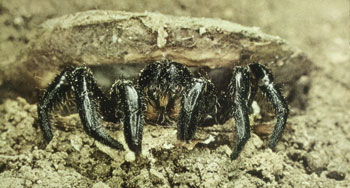
While hunting its prey, the trapdoor spider keeps only its front legs outside.
Desert climates can be lethally hot for many living creatures. Nevertheless, some creatures have skills which enable them to survive in the desert despite the heat. Either their hunting techniques, the construction of their bodies, or their modes of behaviour enable them to live comfortably in a desert environment. One species of the subject of this book, the spider, possesses the characteristics necessary for living in the desert. This living thing, known as the "trapdoor spider" uses its insulated home in the desert floor both to protect it from the heat and as a trap to catch its prey.
First of all the spider digs a burrow in the ground. It sticks tiny bits of earth together with a special fluid it produces and plasters the inside of the tunnel. This process strengthens the walls against the danger of collapse. Later it covers the walls in a thread it makes. This plastering technique is similar to the thermal insulation technique we use today. In this way the inside of the nest is made resistant to the high desert temperatures outside.
We mentioned how the second feature of the nest was its use as a trap. The spider makes a cover for the nest out of its own silk. One side of this is attached by a hinge made of strong thread to the nest, turning it into nothing less than a door. This door also helps the spider conceal itself from its prey. It camouflages the cover with bits of brush, scrub, and soil. Then it stretches taut threads under the leaves, from the outside of the nest in. When an insect approaches the nest and steps on the leaves or the earth, the underground threads start to vibrate. Thanks to these vibrations the spider can tell that prey is near. When everything is in position, the spider enters its nest and waits for its prey.
The trap-door spider can live up to 10 years in its burrow. It spends all its life in the dark tunnel and almost never emerges. Even when it opens the cover to seize its prey its back legs do not leave the nest. If the cover is opened with a twig the spider will come to the entrance and make great efforts to close it up again. Females never leave the nest, while males only do so to find a mate. When it is time for the female to produce its offspring, it firmly closes the entrance, sticking the cover to the doorway with its own thread. In this way it has been observed that the mother spider can spend a year in the nest without leaving it.
Trap-door spiders hunt at night and keep the covers of their nests firmly shut by day. As night starts to fall the spider pushes the cover partly open to see whether it is fully dark yet. If it is dark it pushes the cover partly open and rests its front legs outside. It can remain in this position for many hours. When ants in particular approach the spider immediately jumps on them at lightning speed and drags them down into its burrow. The cover closes again under its own weight.
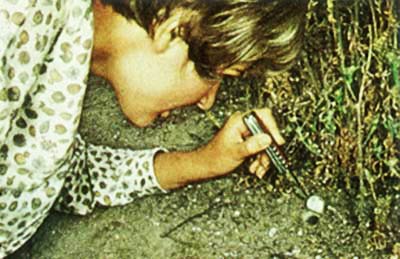 | 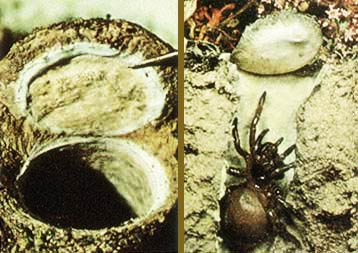 |
These pictures show the entrance to the trapdoor spider's nest.
There is no doubt that in order to learn to live in the manner described above some abilities requiring intelligence, for example construction ability, will be needed. It will not be possible for the spider to fabricate insulation from the heat or to camouflage itself in the sand through coincidence or trial and error. Even before it starts to build the tunnel, it "knows" that it will use its silk to protect it from the heat, that it will use the same thread to make a cover for the nest, that it will use its nest to hide from enemies and also as an incomparable trap, and that it will give birth to its young in safety in this silk-padded nest. Were it not so, the first trap-door spider to emerge would have died of heat or hunger in the middle of the desert. That would mean the end of the species.
Furthermore, every new-born spider behaves in this same way. It builds its nest in the same way and feeds in the same way. Therefore it was not enough for the first spider to have these surprising features, it also had to be able to pass all its knowledge on to later generations. This can only happen by this knowledge being fixed in the spider's genes. But notwithstanding all these facts, we are still faced with questions. How did the trap-door spider come to have these characteristics, and who fixed them in its genes?
These intelligent behaviour patterns, planning capability, tactical selection and implementation, and flawless bodily construction, which proponents of the theory of evolution try to explain by such concepts as instinct, imaginary mechanisms, coincidence, or Mother Nature, can actually have only one explanation. It is God Who gave all living creatures the skills they have, or Who created them with these skills already in place. God possesses incomparable knowledge.
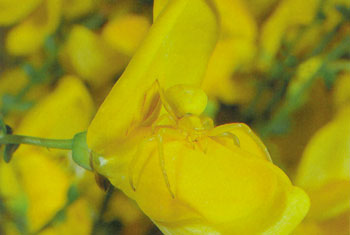
The colours of the flowers and the spider in this picture are identical. So much so that some insects mistake the spider for a flower and land on it. The power which made these two living things so adapted to each other, of identical colour, is God.
Contrary to common belief, many types of spider hunt without building webs. One such spider, which catches its prey without a web, is the crab spider. It disguises itself inside flowers and feeds on bees which land on them.6
The crab spider uses its ability to change colour to match the yellow or white of the flower. It completely conceals its legs in the middle of the flower and settles down to wait for its prey. The spider matches the colour of the flower it hides in to perfection. It is only by the most careful inspection that the spider can be distinguished from the flower.
The spider goes into action when a bee lands to suck the nectar from the flower in which it is lying in ambush. At that very moment the spider slowly wraps its legs around the bee, then, in a sudden movement it bites it in the head, injecting its venom straight into its brain and then eating its prey. The spider can disguise itself so cunningly in the flower that sometimes a butterfly or a bee will land right on top of it without realising it.
Did the spider decide to be able to take on these colours by itself, by any chance? Did it study flowers and copy the same tones and shades in itself? It is clear that the spider would not have had the ability to do that. Apart from a few nerve centres, it does not even possess a brain capable of thinking. Furthermore, the spider is colour-blind. It can perceive neither yellow nor pink. Even if we accept for a moment that it could manage to match itself to the exact colours and tones it saw, it would still not be possible for it to reproduce this within its own body. It is God, the Owner of superior power, Who enables the spider to distinguish and reproduce colours is God.
It is obvious that the flowers and the spider have been created to match each others' colours by God. It is as if two pictures had been done on the same canvas with the same paints and brush in the same colours and tones, in a match that cannot be explained by any fairy tale-like coincidence.
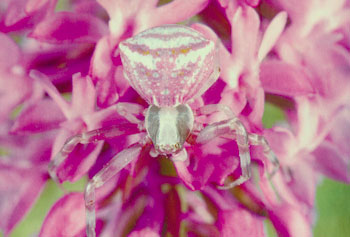 | 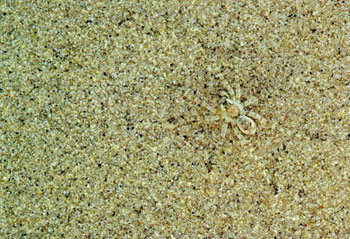 |
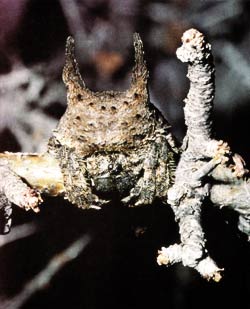 | As well as being the same shade of colour as the flowers they wait on, some spiders even have the same patterns (side). The spider (bottom right) exactly matches the sand it walks on. One has to look very carefully to distinguish the spider from its background. The Caerostis spider hunts at night. (left) At dawn it dismantles its web and waits for night again. The twig, which it resembles, and which it sits on all day, camouflages it. |
Spiders' webs are death traps for many living things. But there are some creatures which can survive this deadly trap. For example, a normal moth is impervious to spiders' webs. Because the dust on the moth's body renders the sticky bits of the web ineffective. Thanks to this property the moth is easily able to escape.
But moths can still be caught in webs of a construction which is different from normal ones. The web of the Scoloderus spider, which lives in tropical areas, is different from most webs, and closely resembles fly-paper. In this way Scoloderus can easily catch moths. The Scoloderus spider builds a web a meter long and 15-20 centimetres wide, resembling a ladder. Moths caught in them fall down to the bottom of the web. During the long fall they lose most of the protective covering which prevents them sticking in normal webs, and so are caught in Scoloderus' trap.
So this spider has a hunting technique very different from that of other species. The point of note in this method of hunting is that the spider produces a web with features enabling it to catch the insect it hunts. This species of spider, with its different web construction, is one of many pieces of evidence testifying to God's infinite art of creation.
This ogre-faced spider, or Dinopis, to give it its scientific name, employs a very unusual and surprising hunting technique. Instead of building a fixed web and waiting for its prey, it builds a web with a few special features, and casts this over its prey. Then it wraps its prey up in this web. The trapped insect is doomed. Then, the spider wraps its prey in new threads, in a "packet," to keep its food fresh for later.7
It is evident that the spider catches its prey within the framework of a plan. The planning and subsequent production of a web of the correct size, shape and strength, etc, which is exactly suited to this hunting method, and then the wrapping up of the prey, are all activities requiring superior capacities based on intelligence. Furthermore, an examination of the spider's web's construction features reveals them to be faultless.
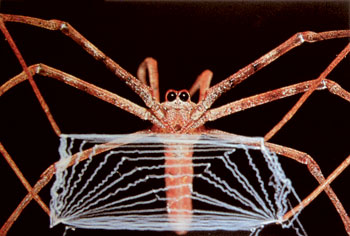
The web of the Dinopis, unlike that of other spiders, possesses the unique feature of being thrown over its victim.
Dinopis' web is a wonder of planning in every sense. Just the chemical make-up of the silk it uses is a miracle on its own. The technique the spider employs to use its web is also particularly interesting. While the spider waits for its prey, the web resembles a narrow cage built out of straws. But this harmless appearance is in reality a deception. When the spider goes into action to catch its prey, it uses its legs to turn the web inside out, making it a death trap from which there can be no escape.
But how is the spider able to build a web of such perfect mechanical planning and chemical construction? It is no simple matter to do tasks which require planning, no matter how straight forward. Each one needs a different plan and experience. We can demonstrate this as follows. When describing spiders' webs we often use the expression "like lace." For this reason it will not be incorrect to say that with their webs spiders actually are making lace.
Let us imagine that the man in the street is given the implements used to make lace (tatting shuttle, needles, thread, etc.) and the cotton. Can we expect this person, who has no previous experience, to make something in lace at the first attempt? Or can we imagine a lace table-cloth emerging from knots made by coincidence? Of course not.
It is impossible for a plan to emerge by itself, because for a plan to emerge, intelligence, skill, and a means of imparting information are necessary. For a living creature to make plans, and if, furthermore, it carries out these plans with no faults in their execution, this creature must be "intelligent." However, it is not possible to accept that an insect can be intelligent, that it can think, think of plans. This is a banal chain of logic used to try to arrive at the truth, and does not reflect reality. For which reason there must be a power which gave the insect its intelligence, or rather which directs it, which taught it what it does, or rather makes it do it. In other words the insect must have a Creator.
As we have seen, it is an obvious truth that these living creatures were created by God. But evolutionists ignore this, and instead build upon possibilities. Their wilful slavery to their theories makes them incapable of understanding, seeing, or hearing. It has led them to a state where they cannot see an obvious truth and cannot accept what they see and understand.
 |
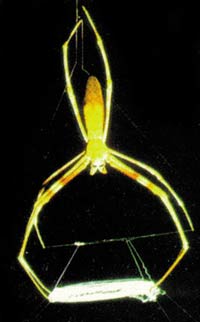 |
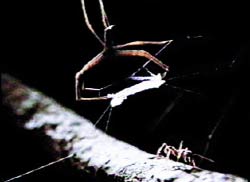 |
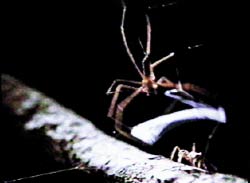 |
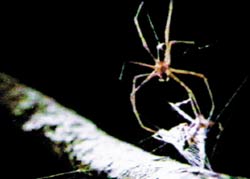 |
These pictures show the stages of the Dinopis' hunting technique. The spider hangs on a thread it has tied to a branch or leaf. Then it waits in ambush. There is no escape for the prey which passes under it. The spider suddenly jumps and throws its web over its prey. |
According to evolutionists, Dinopis spun its web with the features we have described above, by chance, and also learned to use it by chance. Any intelligent person can see that such a thing is impossible. But let us for a moment accept, despite its clear impossibility, that such a thing is possible and that the first Dinopis managed to spin such a web by chance. (We shall ignore such questions as how Dinopis first came to be, and how it produced the chemicals necessary for its web inside its body, taking them as given). In this case the following questions need to be answered: If the first web was spun by chance, how did the second and third webs come to be spun? How did the spider manage to reproduce exactly the same web, which it had spun by chance? How did a newly-born spider know how to spin a web like lace, to spin a web with qualities different from those of others, and that it would have to throw the web over its prey?
There is only one answer to these questions. The spider, incapable of learning, or learning by heart, and lacking even a brain sufficiently developed to do these things, was endowed with these things by God, the omnipotent Creator of all living things.
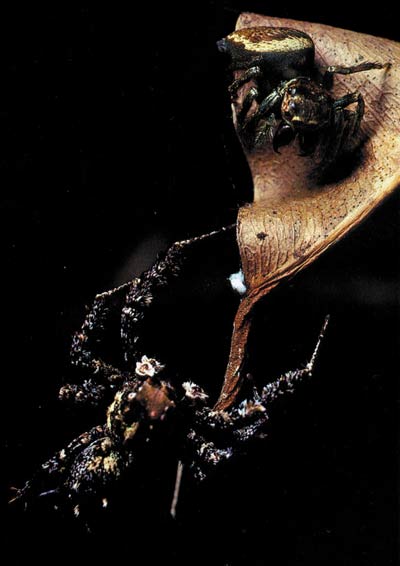 Portia spiders imitate and hunt their own species. For example, Portia (the bottom spider), in the picture, deceives the female Euryattus (the top spider) by mimicing the mating ritual of the Euryattus spider which lives in a rolled-up leaf suspended by silk cables. Of course it is impossible for a spider to come by and employ this "imitative skill" all by itself. The spider was created by God to have this property. |
In contrast to most other spiders, Portia Fimbriata both builds a web and hunts away from its own web. Another feature of Portia is that it prefers members of its own species over insects as food. For this reason Portia's field of activity is generally other spiders' webs. It uses a fascinating stratagem when hunting.
Generally, Portia will land on a web while the wind is blowing or while an insect is struggling to free itself. Such strong vibrations mask the shaking caused by a Portia on the prowl.
To look at, it resembles a scrap of vegetation blown into a web by the wind. Unlike other spiders, which jump excitedly on to their prey when they see it, Portia moves slowly. Once it is installed on the web, it manipulates, plucks and slaps the web silk with its legs, mimicking a trapped insect. When the owner of the web approaches, Portia is ready and waiting in ambush.8
Portia spiders deceive members of their own species by imitating them. For example, Portia mimics the mating ritual of the Euryattus spider, which lives in a rolled-up leaf suspended by silk cables.
Sitting atop a female spider's home, Portia rocks the leaf, dancing atop it like a Euryattus male. Fooled for the moment, the spider emerges from its home.9
How does Portia match signals with different types of spiders and why did it select such a different method of hunting? It is not logical to suggest that a spider could have an "imitative skill" and because of this should choose such an interesting hunting technique.
The spider hunts in this way because that is how it was created by God. In such examples, God shows us the incomparable nature of His art of creation.
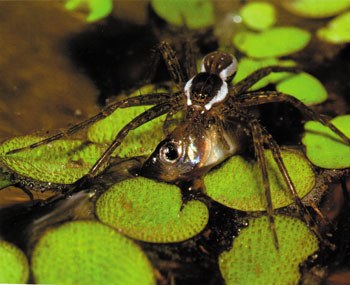
This species of spider can move comfortably on water, thanks to the waterproof liquid on its legs. The picture shows a water spider which has caught a fish.
Some spiders hunt in even the most unexpected environments. For example, the hunting field of the water-spider Dolomedes is the surface of water. This spider is mostly to be found in shallow places such as marshes and ditches.
The water-spider, which lacks good eyesight, spends most of its time by the side of the water spinning threads and spreading them over its surroundings. These serve two functions at the same time: they are a kind of warning to other spiders, setting the limits of its own territory, and they also form an escape route in the event of unexpected danger.
The spider's most frequently used hunting method is to put four of its legs on the water while the other four hold on to dry land. While doing this, it employs a most clever technique to avoid sinking. The spider covers those of its legs which will go into the water with a water-proof coating by passing them through its fangs. It then approaches the edge of the water. Pushing its body down with great care, it moves on to the surface of the water. It places its fangs and feelers under the water in such a way as not to disturb the surface. It waits for a living creature to approach, with its eyes looking around it and its legs feeling for vibrations in the water. To feed itself, the spider needs to find prey at least the size of the "Golyan" fish, which we see in the picture.
When the spider is hunting, it stays motionless until the fish comes within 1.5 centimetres of its jaws. Then it suddenly enters the water, catches the fish in its legs, and bites it with its venomous fangs. Then, in order to stop the fish, which is much bigger than it, from dragging it under the water, it immediately turns upside down. The venom quickly takes effect. It not only kills the prey, but also dissolves the prey's internal organs, turning them into a kind of soup and making them easy to digest. When the prey is dead, the spider drags it on to the shore and feeds.10
At this point various questions spring to mind. How did the spider come by that wax which stops it sinking? How did it learn to coat its legs with it against the risk of sinking? How did the spider come by the wax's formula and how did it make it? The spider certainly did not bring about all of these things—each one of which bears the mark of intelligence—of its own volition. Like all other living creatures, this species of spider acts in such an intelligent way, is capable of making such a plan and putting it into practice by inspiration from God. In one of His verses, God states that He gives every creature its own provision:
There is no creature on the earth which is not dependent upon God for its provision. He knows where it lives and where it dies. They are all in a Clear Book. (Surah Hud: 6)
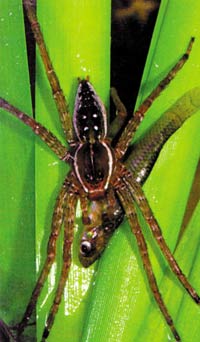 | 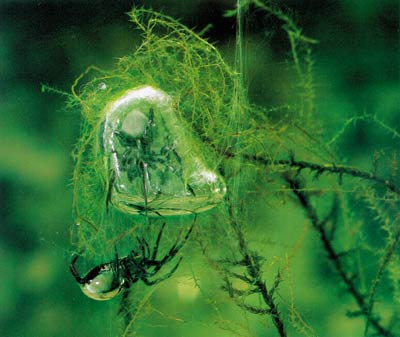 |
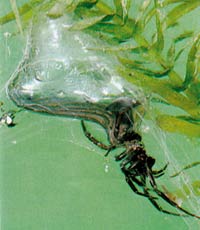 | The water spider's bubble in the picture is planned in the most ideal way for living under water. It is impossible for a spider to have found a way of living under water by chance. It is God Who created the spider with these characteristics. Spiders, which wait in ambush on their fragile webs and hide amidst bushes, were created as real killing machines. They can even walk on water to hunt (right). When necessary they can construct a bell and even live under water. |
The water spiders of the warm regions of Asia and Africa spend a lot of their time under water, and so make their nests in the water.
In order to build its nest, the spider first of all constructs a platform between plant stems or leaves in the water. It attaches the platform to the stems with silk threads. These threads indicate to the spider the way back to its home, stabilise the platform, and also work like radar, giving warning of the approach of prey.
 The raft spider preparing to hunt on water. | 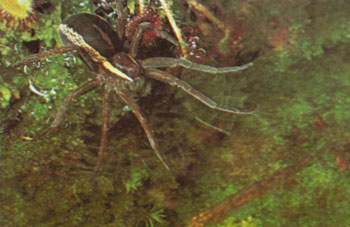 The spider, which senses movement in the water through its legs, waits motionless until a "Golyan" fish approaches. |
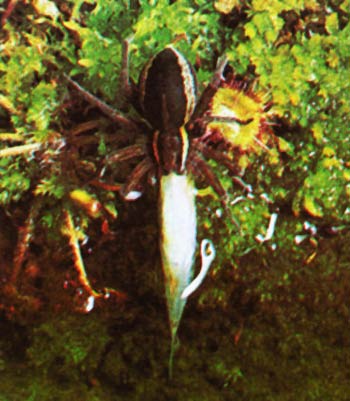 | 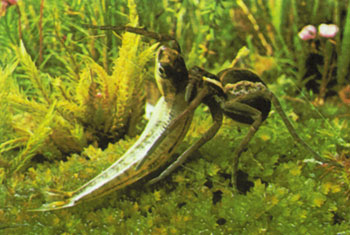 After catching and poisoning the fish, it drags it to the shore. |
After constructing the platform, the spider carries air bubbles under it with its legs and trunk. In this way the web swells upwards, and as more air is added, it takes on the appearance of a bell. This "bell" is the nest where the spider lives.
By day the spider waits in its nest. Should any small animal pass by, especially an insect or a larva, it rushes out, grabs it, and drags it back to the nest to consume. An insect falling on to the surface of the water sets off vibrations. The spider senses these, goes up to the surface, seizes the insect and drags it beneath the water. The spider even uses a web on the surface of the water. It makes no distinction between an insect which falls into this and any other victim.
As winter approaches, the spider has to take precautions if it is not to freeze. For this reason, as winter draws near, the water-spider goes down deeper. This time it builds a winter bell and fills the inside of it with air. Some other spiders move into empty sea-snail shells. It never moves inside the bell, and expends hardly any energy throughout the whole winter. This is to conserve energy and so reduce its need for oxygen. These precautions mean that the air bubbles it carries to the bell can last it for the 4-5 winter months.11
As we have seen, the spider's air bubble and hunting methods are the ideal way for a spider to be able to live under water. It is impossible for a living creature to find a way of living under water by chance. If a creature does not have the features necessary for living under water, then it will drown the first time it enters the water. It will not have time to wait for coincidence, or anything else. Therefore, a land creature, which can live under water by virtue of having the right skills to do so, owes its existence to the emergence of such skills. And this shows us that the water-spider, with these distinctive characteristics and abilities, was created by God in a perfect manner.
I have put my trust in God, my Lord and your Lord. There is no creature He does not hold by the forelock. My Lord is on a Straight Path. (Surah Hud: 56)
Some species of spiders in the Namibian desert in South-west Africa, when faced by danger, fully retract their legs and make their bodies exactly like a wheel. Then, with a series of somersaults with their wheel-shaped bodies, they rapidly move away from the danger.
These spiders measure some 2.5-3 centimetres and can move quite quickly, at 2 metres a second. In order to grasp what this speed means, let us give an example. The rotation of the spider's body in its wheel form is that of the wheels of a vehicle moving at 40 kilometres an hour.
Some species of spider use this technique to flee from their enemies. Most of the time these enemies are wild female raider wasps. When the spider, which builds it nest on the tops of sand hills, senses the wasps beginning to dig at its nest, it rushes outside. First it takes a few steps to build up speed, then it folds in its five-jointed legs, and gathering speed like a wheel rolling downhill, flees. If the spider built its nest at the bottom of sand hills, then it would be unable to get up the necessary speed and would be caught. For that reason it chooses to build its nest at the tops of the hills. That it should take such a precaution as to build its nest on a hill, without having come across an enemy, is a conscious piece of behaviour. Without doubt it was God Who inspired it to do this. God creates without any preceding example, and He is aware of all creation.
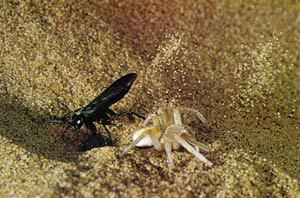 | 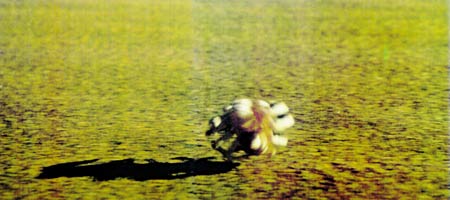 |
This spider, which purposefully builds its nest on the top of sand hills, springs out as soon as a wild bee begins to dig at its nest. (Side picture) In order to build up speed, the spider first takes a few steps, then, folding in its five-jointed legs, it moves quickly, like a wheel rolling downhill.
The species of spider known as Scytodes kills its victims by squirting a mixture of toxin and gluey substance over them. These liquids are produced in an enormous gland behind the spider's eyes, which is divided into two compartments:one contains a toxin, the other a gluey substance. The spider contracts the muscles surrounding the latter and a stream of glue is rapidly ejected from the animal's fangs. Sprayed out in a zig zag pattern, the adhesive forms a net that fixes the prey to the leaf or twig it happens to be traversing.12 Then having immobilised its prey and stuck it on to a branch or leaf, it can eat it later where it hangs.
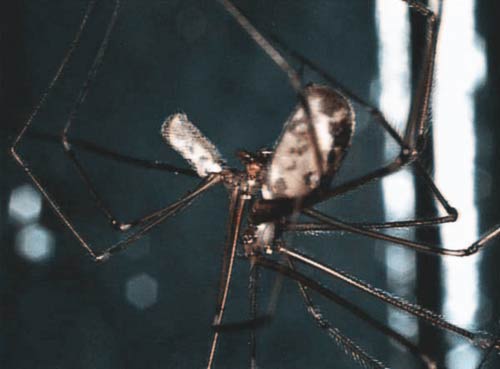
Pasilobus, only to be found in New Guinea, is a great expert at preparing traps. The webs it spins are very sticky. The whole web is slung between two fixed points. The knot at one end is very tight, but the one at the other end is left quite loose. This is not a mistake, and is not a result of the spider's not concentrating. That this is a hunting strategy can be seen when the prey approaches. When a moth flies into the web, the loose loop end becomes detached. Because the other end stays fastened, the insect remains hanging like a bundle in the air. Later the spider approaches it and sprays a sticky material all over it, starting from the head. In this way the spider catches its prey alive.
4- Gardner Soul, Strange Things Animals Do, G.P.Putnam's Son, New York, 1970, p. 89
5- Gardner Soul, Strange Things Animals Do, G.P.Putnam's Son, New York, 1970, p. 90
6- Liz Bomford, Camuflage and Colour, Boxtree Ltd., London, 1992, p. 108
7- The Guinness Encyclopedia of the Living World, Guinnes Publishing, s. 164
8- National Geographic, November 1996, Vol. 190, No.5, p.106
9- National Geographic, November 1996, Vol. 190, No.5, p.111
10- Bilim ve Teknik Görsel Bilim ve Teknik Ansiklopedisi (Science and Technology Gorsel Science and Technology Encyclopedia), p. 494, 495)
11- Bates Hayvanlar Ansiklopedisi (Bates Encyclopedia of Animals), p. 244
12- Natural History, Tools of the Trade, 3/95, p. 48